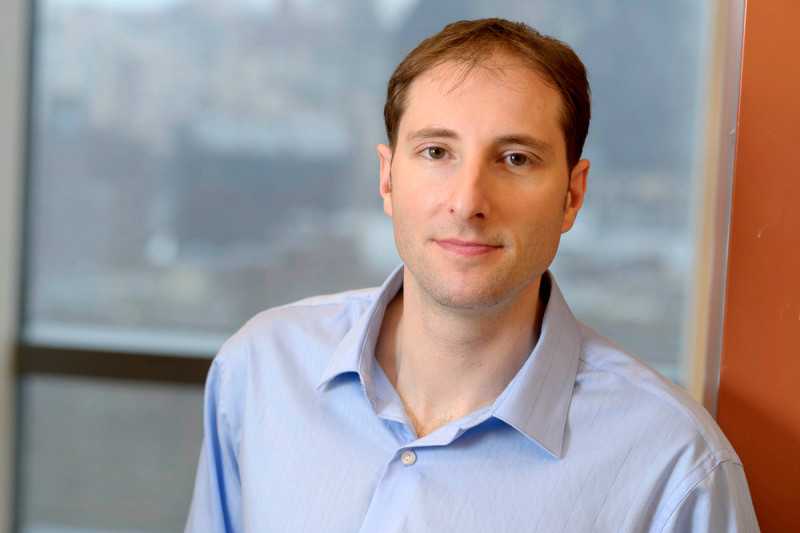
Cancer biologist Michael Kharas investigates the molecular processes that stem cells and tumor cells have in common. Clarifying these processes could guide the development of new approaches to treat cancers such as leukemia. We spoke with Dr. Kharas in 2012, a year after he joined the Sloan Kettering Institute.
When I was ten, a friend asked me if I wanted to be a doctor when I grew up. “No,” I recall saying, “I want to be making the drugs doctors use to cure people.”
I’m not sure how this idea got into my ten-year-old head, but today I feel incredibly fortunate to be leading a laboratory in the Molecular Pharmacology Program of the Sloan Kettering Institute — the best place imaginable for someone who wants to help develop new treatments for cancer and other diseases.
Growing up, my brother and I got used to moving from place to place. Both of our parents studied chemistry, and their academic journeys took them from the former Soviet Union to Israel (where I was born), and then to the US. They share a penchant for science, the arts, theater, and music — all of which has had a huge influence on me.
During my first year of high school, I followed my father’s advice to work as a summer student in the lab of one of his colleagues at DePaul University in Chicago.
I soon realized that what I had learned about science in school had little to do with what really makes science so thrilling. Being in a real laboratory gave me my first sense of the spine-tingling excitement one feels in trying to unravel something no one knows.
A Glimpse of Translation
During the high school summers that followed, I worked in the lab of Sergei Mirkin at the University of Illinois, investigating the structure and function of trinucleotide repeats — normal features of DNA that sometimes become expanded and have been linked to some neurologic disorders, including Huntington’s disease.
My mentor, Elena, taught me all the basics of molecular biology. What I didn’t know until later was that Elena had been diagnosed with advanced breast cancer.
When she died, I was very distressed by the notion that medicine had had so little to offer her. I soon embarked on my undergraduate studies in biochemistry at DePaul, and felt strongly motivated by the notion that research might one day make a real difference for people with serious diseases such as Elena’s.
In 2001, I enrolled as a graduate student in the lab of David Fruman, at the University of California, Irvine. A great mentor, David had a cancer-related project running in his lab, and he offered me the opportunity to work on it.
My task was to investigate how some types of leukemia cells receive and respond to signals in their environment. A number of signaling pathways — including the PI3 kinase pathway, which my graduate work focused on — are intimately linked to cancer growth and progression because they initiate cellular processes that alter the fate of the cell.
My colleagues and I studied ways to target this pathway therapeutically in mouse models of leukemia. Working in David’s lab, I had a first glimpse of the immediacy with which some basic science discoveries might be translated into the clinic, and ultimately benefit patients.
As I was finishing up my graduate work, I had no doubt that I wanted to pursue a career in science.
Connecting Cancer and Stem Cells
In 2006, I moved to Boston to begin postdoctoral training at Harvard Medical School, in the lab of Gary Gilliland. Characteristic of Harvard, the lab was teeming with brilliant people, everyone running in their own direction. It was both chaotic and wonderful.
Scientists were increasingly intrigued by a connection between cancer and stem cells, the cells from which various types of normal cells and tissues originate. As Gary and others have found, there are characteristics inherent in stem cells that tumors need in order to grow and progress. The most aggressive cancer types appear to be mimicking certain traits of stem cells, such as the ability to regenerate.
To better understand this phenomenon, my colleagues and I began investigating what leukemia cells have in common with hematopoietic stem cells, from which normal blood cells develop. Using gene expression profiling, we identified a protein called Musashi-2, which both leukemia cells and hematopoietic stem cells produce in high amounts.
A few years later, when Gary left Harvard, I was very fortunate to continue my research in the lab of George Daley, at Children’s Hospital Boston. My colleagues and I discovered that Musashi-2 plays a role in some of the most aggressive types of acute myeloid leukemia (AML).
At the cellular level, the protein functions by binding to RNA, regulating the expression of numerous genes. It appears to be part of a genetic process that determines the fate of a hematopoietic stem cell — instructing it to either remain a stem cell or start differentiating so as to eventually become a red blood cell, lymphocyte, or other type of blood cell.
Our research has indicated that the same genetic process often is disrupted in AML, contributing to the aggressive course the disease takes in some patients. It is tempting to speculate that future cancer therapies designed to manipulate the function of Musashi-2 could provide a new form of therapy that selectively targets leukemia cells with stem-cell-like characteristics.
A Black Box
Currently, it is not well understood how the process that modulates a cell’s switch from “stemness” to differentiation works at the molecular level. As I was finishing up my training and applying for jobs, my dream was to have my own lab, where I would be able to address this and other questions. I felt extremely honored when I was given the opportunity to join the faculty at Memorial Sloan Kettering, where I have been since 2011.
My colleagues and I are exploring the mechanism by which Musashi-2 controls the fate of stem cells and tumor cells, and identifying other RNA-binding proteins that have a similar function. Clarifying this process may inform the development of new approaches to treat some cancers and blood disorders — for example, in the context of bone marrow transplantation.
As in many other areas of biology, research on stem cells is largely a black box. I think we will be busy for a long time prying the box open. What eggs me on is the idea that we might one day be able to extract something useful — a sliver of understanding moving us one step closer to controlling cancer and other diseases.

